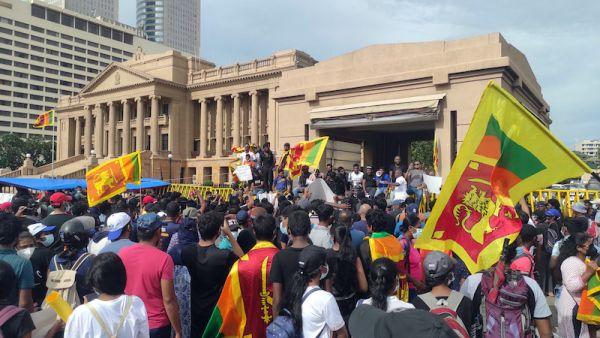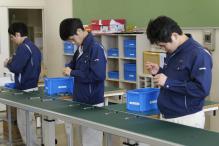It would be an understatement to say Sri Lanka had a tumultuous 2022. After mismanagement of the response to COVID-19 and the related economic crisis caused widespread protests, regime change finally seemed at hand. But food and fuel shortages, rolling blackouts, and huge price increases for essential goods have continued, and the crackdown on peaceful protest leaves many frustrated Sri Lankans with no clear path forward.
From April to August a huge ‘Occupy-style’ protest site sat outside the Presidential Secretariat building on Galle Face Green. The site was nicknamed ‘GotaGoGama,’ a play on the Sinhalese word for village and the protesters’ demand that President Gotabaya Rajapaksa—or ‘Gota’ as he’s popularly known—needed to ‘get going’ and leave office. After protesters famously breached the building’s gates last July and swam in the palace pool, President Rajapaksa fled for the Maldives, and his newly-appointed successor, Ranil Wickremesinghe, ordered security forces to raid the protest camp and arrest demonstrators.
This marked a new, more authoritarian turn for Wickremesinghe, previously viewed as a moderate political veteran. His continued use of the controversial Prevention of Terrorism Act (PTA) has specifically targeted human rights activists, journalists, and lawyers critical of the government, leading to widespread condemnation from organizations and scholars, including Amnesty International, demanding a moratorium on its use. President Wickremesinghe also continued using emergency regulations, granting additional powers to law enforcement and restricting freedom of movement and expression, including social media blackouts.
Sri Lanka’s debt crisis and its impacts on the poor
Against this backdrop, Sri Lanka has also experienced a growing debt crisis, the worst in the country’s 74-year history, which threatens to inflict further hardship on the Sri Lankan people. The current group of lenders, including hedge funds and other private sector creditors, own almost 40 per cent of Sri Lanka’s external debt and are profiting from the insecurity, delaying a deal when debt negotiations are at a ‘make or break’ point.
A statement from economists, activists and academics has called on all lenders—bilateral, multilateral, and private—to “share the burden of restructuring, with assurance of additional financing in the near term.” This is a particular challenge for Sri Lanka’s relations with China. The country owes China $6.5 billion in financing for its investments in major infrastructure projects, including a highway, port, and airport.
Aside from top-level criticism from academics and economists on the need for debt restructuring and relief, civil society groups are also pushing the Sri Lankan Government to address the needs of the working class poor. With harvests at a fifty-year low and over a third of the population defined as ‘food insecure,’ there is an escalating need to address recovery—now.
The Government’s prioritizing of ‘economic efficiency’ has exacerbated the hardships faced by Sri Lanka’s poor, leaving many with no access to basic amenities. The community of Seevalipura, for example, was left to fend for itself in the struggle to access clean drinking water after the National Water Board experienced a record-breaking loss of Rs. 3.1 billion in 2021 (an eight-fold increase on the previous year).
Attempts to tackle economic efficiency by raising the rates individuals pay for basic services has alienated vulnerable communities, failing to account for their fluctuating income and frequent displacement. Compounding this hardship, many have been moved from dwellings on state land that they occupied for generations to newly-built high rises with unaffordable rents and unreliable access to water.
The Government’s budget presented last November was roundly criticized by groups working on social and economic rights, particularly women’s groups which document the terrible effects of the economic crisis on debt cycles in poor families, leading to the breakdown of marriages and domestic violence.
Women at the center of the crisis (and the response)
Across the country, but especially in the war-affected north and east where women-headed households are more prevalent, the economic crisis, with its food shortages and massive inflation, has disproportionately affected women providing for their families at a time when established state assistance benefits are falling short.
This has led to a ‘quiet protest.’ In the eastern city of Batticaloa, for example, women have undertaken a ‘walk for justice,’marching silently in single file from temple to church to mosque. This is not the first time such resistance has been undertaken; the ongoing protests against forced disappearances over three decades of war have been a hallmark of post-war women-led protest in the north and east. But, those walking are markedly different from the circus of protests characterized by the ‘GotaGoGama’ movement. They are careful not to violate curfews or other government restrictions, they are predominantly women-led, and they are not satisfied by changes in political office. What they are after, in their own words, is “fundamental system change.”
Alongside the fuel queues and ceaseless traffic, the street markets and the heavy police presence, women are taking up space and refusing to go home. One placard quotes Tamil poet Bharathiyar: “Did you think we would fall?” Despite being targeted by State intelligence officers and harassed by some onlookers in the street, they have continued their quiet resistance, and in the process opened up space for discussing what brought on these series of crises and what systemic changes are needed to break the cycle.
Where next for Sri Lanka?
Back in Colombo, lawyers and activists recently celebrated the release of a student activist, Wasantha Mudalige, who had been detained under the PTA since August. Pressure is growing on President Wickremesinghe to repeal the law, and to hold elections so that people can decide who will lead them out of this dark chapter. The economy is set to contract by 10 per cent in the coming year, and the President has much work to do to address the corruption and overreach of executive power that were the trademarks of his predecessor.
Two-thirds of lower income countries are at risk of defaulting on their debts as interest rates rise, exacerbating the cost-of-living crisis. Sri Lanka is now the bellwether for how the international lending system can deal with debt relief and restructuring. The country is also a case study demonstrating the consequences of not enacting much-needed political reforms. The protesters driven to desperate measures are mobilizing in their various guises across the country and circling the palace gates, metaphorically, at least for now.
Dr Tara Quinn is a postdoctoral fellow in Peace and Conflict Studies at the University of Utah. She completed her thesis, Resistance in Transition: Land, gender and transformative justice in postwar Sri Lanka at Coventry University’s Centre for Trust, Peace and Social Relations.
Suggested citation: Tara Quinn., "Sri Lanka at a Crossroads: Where Next for the Protest Movement that ‘Went Home’?," UNU-CPR (blog), 2023-07-25, 2023, https://unu.edu/cpr/blog-post/sri-lanka-crossroads-where-next-protest-movement-went-home.




